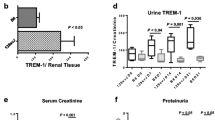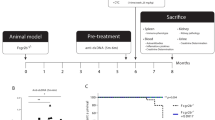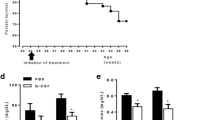Abstract
Macrophage migration inhibitory factor (MIF) is a potent pro-inflammatory cytokine that also counter-regulates glucocorticoid action. We investigated whether immunoneutralization of MIF could reverse established experimental crescentic glomerulonephritis and if this treatment could modulate endogenous glucocorticoid levels. Accelerated anti-GBM glomerulonephritis was induced in six littermate pairs of rats. Once crescentic disease was established on day 7, one animal in each pair was given a daily injection of neutralizing anti-MIF antibody (Ab) or irrelevant isotype control Ab for 14 days and then killed on day 21. In addition, a group of 6 animals was killed on day 7 of disease without any treatment. Animals receiving the control Ab exhibited a rapidly progressive glomerulonephritis with severe renal injury (proteinuria), loss of renal function (creatinine clearance), anemia, and marked histologic damage (including glomerular crescent formation), compared with animals killed on day 7 without treatment. In contrast, anti-MIF Ab treatment partially reversed the disease by restoring normal renal function and reducing histological damage compared with untreated animals killed on day 7 (p < 0.05). Interestingly, anti-MIF Ab treatment also prevented severe anemia (p < 0.05). Reversal of disease was associated with a significant reduction in leukocyte infiltration and activation and renal interleukin-1 (IL-1) production. Importantly, anti-MIF Ab treatment caused a significant increase in endogenous serum corticosterone levels, which correlated with the reversal of disease parameters. In conclusion, this study has demonstrated that blocking MIF activity can partially reverse established crescentic glomerulonephritis and suggests that MIF operates by both enhancing the cellular immune response and suppressing the endogenous anti-inflammatory glucocorticoid response.









Similar content being viewed by others
References
David JR. (1966) Delayed hypersensitivity in vitro: its mediation by cell-free substances formed by lymphoid cell-antigen interaction. Proc. Natl. Acad. sci. U.S.A. 56: 72–77.
Bloom BR, Bennett B. (1966) Mechanism of a reaction in vitro associated with delayed-type hypersensitivity. Science 153: 80–82.
Calandra T, Bucala R. (1997) Macrophage migration inhibitory factor (MIF): a glucocorticoid counter-regulator within the immune system. Crit. Rev. Immunol. 17: 77–88.
Bernhagen J, Bacher M, Calandra T, et al. (1996) An essential role for macrophage migration inhibitory factor in the tuberculin delayed-type hypersensitivity reaction. J. Exp. Med. 183: 277–282.
Bacher M, Metz CN, Calandra T, et al. (1996) An essential regulatory role for macrophage migration inhibitory factor in T-cell activation. Proc. Natl. Acad. sci. U.S.A. 93: 7849–7854.
Calandra T, Bernhagen J, Metz CN, et al. (1995) MIF as a glucocorticoid-induced modulator of cytokine production. Nature 376: 68–71.
Nishno T, Bernhagen J, Shijki H, Calandra T, Dohl K, Bucala R. (1995) Localization of macrophage migration inhibitory factor (MIF) to secretory granules within the corticotrophic and thyrotrophic cells of the pituitary gland. Mol. Med. 1: 781–788.
Bacher M, Meinhardt A, Lan HY, et al. (1997) Migration inhibitory factor expression in experimentally induced endotoxemia. Am. J. Pathol. 150: 235–246.
Calandra T, Bernhagen J, Mitchell RA, Bucala R. (1994) The macrophage is an important and previously unrecognized source of macrophage migration inhibitory factor. J. Exp. Med. 179: 1895–1902.
Lan HY, Mu W, Yang N, et al. (1996) De novo renal expression of macrophage migration inhibitory factor (MIF) during the development of rat crescentic glomerulonephritis. Am. J. Pathol. 149: 1119–1127.
Lan HY, Yang N, Metz C, et al. (1997) TNF-alpha up-regulates renal MIF expression in rat crescentic glomerulonephritis. Mol. Med. 3: 136–144.
Lan HY, Bacher M, Yang N, et al. (1997) The pathogenic role of macrophage migration inhibitory factor in immunologically induced kidney disease in the rat. J. Exp. Med. 185: 1455–1465.
Bernhagen J, Calandra T, Mitchell RA, et al. (1993) MIF is a pituitary-derived cytokine that potentiates lethal endotoxaemia. Nature 365: 756–759.
Sunderland CA, McMaster WR, Williams AF. (1979) Purification with monoclonal antibody of a predominant leukocyte-common antigen and glycoprotein from rat thymocytes. Eur. J. Immunol. 9: 155–159.
Dijkstra CD, Dopp EA, Joling P, Kraal G. (1985) The heterogeneity of mononuclear phagocytes in lymphoid organs: distinct macrophage subpopulations in the rat recognized by monoclonal antibodies EDI, ED2 and ED3. Immunology 54: 589–599.
Damoiseaux JG, Dopp EA, Calame W, Chao D, MacPherson GG, Dijkstra CD. (1994) Rat macrophage lysosomal membrane antigen recognized by monoclonal antibody EDI. Immunology 83: 140–147.
Hunig T, Wallny HJ, Hartley JK, Lawetzky A, Tiefenthaler G. (1989) A monoclonal antibody to a constant determinant of the rat T cell antigen receptor that induces T cell activation. Differential reactivity with subsets of immature and mature T lymphocytes. J. Exp. Med. 169: 73–86.
Tellides G, Dallman MJ, Morris PJ. (1989) Mechanism of action of interleukin-2 receptor (IL-2R) monoclonal antibody (MAb) therapy: target cell depletion or inhibition of function?. Transplant. Proc. 21: 997–998.
Schotanus K, Holtkamp GM, Meloen RH, et al. (1995) Domains of rat interleukin 1 beta involved in type I receptor binding. Endocrinology 136: 332–339.
Mitchell R, Bacher M, Bernhagen J, Pushkarskaya T, Seidin MF, Bucala R. (1995) Cloning and characterization of the gene for mouse macrophage migration inhibitory factor (MIF). J. Immunol. 154: 3863–3870.
Lan HY, Paterson DJ, Atkins RC. (1991) Initiation and evolution of interstitial leukocytic infiltration in experimental glomerulonephritis. Kidney Int. 40: 425–433.
Lan HY, Nikolic-Paterson DJ, Zarama M, Vannice JL, Atkins RC. (1993) Suppression of experimental crescentic glomerulonephritis by the interleukin-1 receptor antagonist. Kidney Int. 43: 479–485.
Lan HY, Nikolic-Paterson DJ, Mu W, Atkins RC. (1995) Local macrophage proliferation in the progression of glomerular and tubulointerstitial injury in rat anti-GBM glomerulonephritis. Kidney Int. 48: 753–760.
Lan HY, Zarama M, Nikolic-Paterson DJ, Kerr PG, Atkins RC. (1993) Suppression of experimental crescentic glomerulonephritis by deoxyspergualin. J. Am. Soc. Nephrol. 3: 1765–1774.
Lan HY, Mu W, Ng Y-Y, Nikolic-Paterson DJ, Atkins RC. (1996) A simple, reliable, and sensitive method of nonradioactive in situ hybridization: use of microwave heating to improve hybridization efficiency and preserve tissue morphology. J. Histochem. Cytochem. 44: 281–287.
Yu XQ, Nikolic-Paterson DJ, W. Mu et al. (1998) A functional role for osteopontin in experimental crescentic glomerulonephritis in the rat. Proc. Assoc. Am. Physicians 110: 50–64.
Nikolic-Paterson DJ, Lan HY, Hill PA, Vannice JL, Atkins RC. (1994) Suppression of experimental glomerulonephritis by the interleukin-1 receptor antagonist: inhibition of intercellular adhesion molecule-1 expression. J. Am. Soc. Nephrol. 4: 1695–1700.
Tang WW, Feng L, Vannice JL, Wilson CB. (1994) Interleukin-1 receptor antagonist ameliorates experimental anti-glomerular basement membrane antibody-associated glomerulonephritis. J. Clin. Invest. 93: 273–279.
Tang WW, Qi M, Warren JS. (1996) Monocyte chemoattractant protein 1 mediates glomerular macrophage infiltration in anti-GBM Ab GN. Kidney Int. 50: 665–671.
MacPhee IA, Antoni FA, Mason DW. (1989) Spontaneous recovery of rats from experimental allergic encephalomyelitis is dependent on regulation of the immune system by endogenous adrenal corticosteroids. J. Exp. Med. 169: 431–445.
Mason DW, MacPhee IA, Antoni FA. (1990) The role of the neuroendocrine system in determining genetic susceptibility to experimental allergic encephalomyelitis in the rat. Immunology 70: 1–5.
Lacombe C, Da SJ, Bruneval P, et al. (1988) Peritubular cells are the site of erythropoietin synthesis in the murine hypoxic kidney. J. Clin. Invest. 81: 620–623.
Maxwell PH, Ferguson DP, Nicholls LG, Johnson MH, Ratcliffe PJ. (1997) The interstitial response to renal injury-fibroblast-like cells show pheno-typic changes and have reduced potential for erythropoietin gene expression. Kidney Int. 52: 715–724.
Eschbach JW. (1989) The anemia of chronic renal failure: pathophysiology and the effects of recombinant erythropoietin. Kidney Int. 35: 134–148.
Acknowledgments
This study was supported by grants from the National Health and Medical Research Council of Australia (no. 9960106) and the National Institutes of Health (no. 13591). We are grateful to Ms. M. Lo for corticosterone assay.
Author information
Authors and Affiliations
Corresponding author
Additional information
Communicated by R. Bucala.
Rights and permissions
About this article
Cite this article
Yang, N., Nikolic-Paterson, D.J., Ng, YY. et al. Reversal of Established Rat Crescentic Glomerulonephritis by Blockade of Macrophage Migration Inhibitory Factor (MIF): Potential Role of MIF in Regulating Glucocorticoid Production. Mol Med 4, 413–424 (1998). https://doi.org/10.1007/BF03401748
Accepted:
Published:
Issue Date:
DOI: https://doi.org/10.1007/BF03401748




